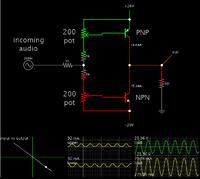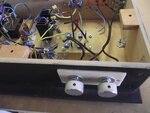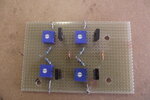unitt
Member level 1

Hi All
If anything going right you will see a circuit.
I will make a line/ headphone amp, the input is a cd player.
I will no feedback and make it as simple as possible.
You will see one channel.
Mine problem is I don't get it working.
I can adjust the transistor, and get the emitter on 0V,
the basis, I measer 0,7V, and 13V on the collector.
But no amplification. I understand that the basis is not
open enough, 0,7V is too less.
I have tried this with Rc is 5K, 10K, but always the same
result. The transistor is BD441.
The basis R are 100K and 200K
Is there someone who can explain tho get it working?
Thank you very much,
Unitt
If anything going right you will see a circuit.
I will make a line/ headphone amp, the input is a cd player.
I will no feedback and make it as simple as possible.
You will see one channel.
Mine problem is I don't get it working.
I can adjust the transistor, and get the emitter on 0V,
the basis, I measer 0,7V, and 13V on the collector.
But no amplification. I understand that the basis is not
open enough, 0,7V is too less.
I have tried this with Rc is 5K, 10K, but always the same
result. The transistor is BD441.
The basis R are 100K and 200K
Is there someone who can explain tho get it working?
Thank you very much,
Unitt
Attachments
Last edited:






